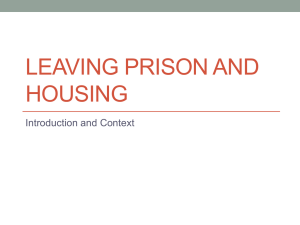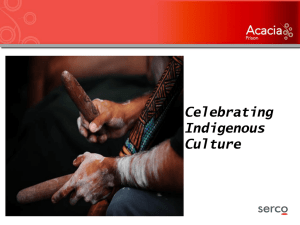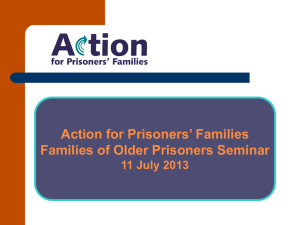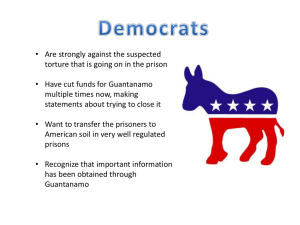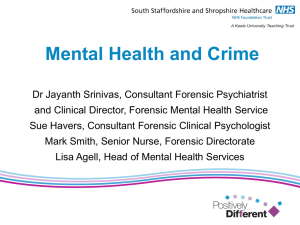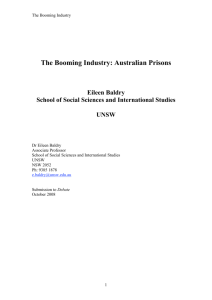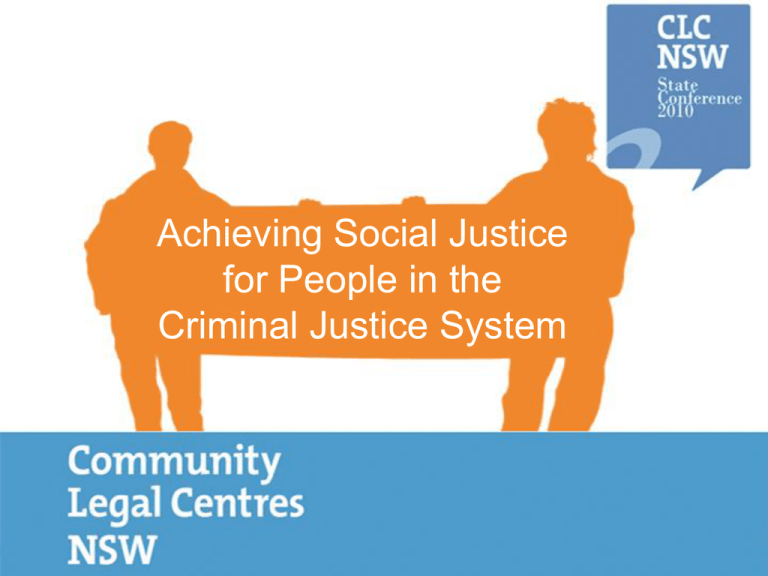
Legal Education and Advice in Prison
for Women
Achieving Social Justice
Hawkesbury
Nepean
for People
in Legal
the Centre
Women’s
Service,
NSW and
CriminalLegal
Justice
System
Wirringa Baiya Aboriginal Women’s Legal Centre
CLC NSW State Conference
May 2010
Legal Education and Advice in Prison
for Women (LEAP)
Overview
Statistical overview of
prison population
•
•
•
•
•
50% of prisoners are incarcerated for less than 6months
Following release 35% reoffend and return to gaol within two years
68% reoffend and return to prison within 5 years
Over 80% return to gaol in their lifetime
In 2008 23% of all prisoners were being held in prison on remand
•
Indigenous people are 13 times more likely to be incarcerated than
non-indigenous people
Indigenous population is 2.1% of NSW population AND 21% of the prison
population (up from 18% in 2005)
Between 1998-2009 the number of indigenous women in prison increased by 73%
1998 - indigenous women represented 21% of the prison population in
2008 - indigenous women represented 30% of the prison population
•
•
•
•
NSW Costs/head: $69K per year open custody, $82K for closed custody
Victimisation
• 70% of prisoners reported they had been either
sexually assaulted or victims of domestic violence prior
to coming into custody (Justice Health Survey)
Mental health overview
Survey conducted over 12 months found that
• 74% of prisoners reported psychiatric/psychological
disorder (86% of women, 72% of men) v
22% in the general population
• 75% reported alcohol/drug addiction population v
19% in the general population
• Post Traumatic Stress Disorder: 55% v 12%
• Average IQ of NSW prisoners: 85 v 100
Legal Education and Advice in Prison
July 2009 – January 2010
Estimates only
• Advice:
105
Information only:
67
• Solicitors see approximately 28 women per month
• 10 clients per prison per month
• This does not include advice and information given through
the Expos which are held quarterly and attended regularly
by all three community legal centres.
Corrective Services NSW
Reported victimisation
• 69% of female prisoners reported at least one violent relationship
35% reported that they had been subject two or more violent
relationships (Butler & Milner 2003)
• A survey of Aboriginal women in prison 80% of women reported
being victims of domestic violence (Lawrie 2002)
•
•
•
•
Sexual assault
60% women/37% men reported a sexual assault before 16 y/o
30% of women/10% men reported a sexual assault before 10 y/o
Nearly 8 out of 10 women report being sexually assaulted as adults
In a survey of Aboriginal women found that 70% of women
surveyed reported being victims of child sexual assault
(Lawrie 2002)
LEAP Experience
Reported victimisation
• N.B. LEAP sols are NOT screening for domestic violence
or sexual assault,
data incomplete
• 80% of Aboriginal and Torres Strait Islander women
report being victims of at least one domestic violence
relationship
• 30% of non-Aboriginal women report being
victims of domestic violence.
• Victims compensation is a primary issue for 25%
of women
• Disclosure is incidental
Case study: Norma, breach
Primary legal issues
Estimates only
child protection
govt admin
victims compensation
domestic violence
family law - contact
wills/probate
civil - other
criminal - drugs
traffic matters
tenancy
Family separation, care and protection
Corrective services statistics:
Age of women
19.2% aged 18-24 y/o
42.4% aged 24-35 y/o
•
•
•
24.9% aged 35-44 y/o
nearly half, 49% men and 57% women have dependant children
(Butler & Milner, 2003)
62% of indigenous men and 79% indigenous women have dependant children
Average number of children: 2.2 for men and 2.4 for women (higher for indigenous
people)
Of prisoners that have been in out of home care:
• 45% of Aboriginal prisoners and 29% of non-Aboriginal prisoners have been in out
of home care at some stage in their lives (John Murray, Positive Justice Centre)
LEAP Statistics
• Domestic violence and care and protection make up over 50% of primary issues
• 10% of primary legal matters are in relation to contact with children
Other issues for our clients
Experiences in prison and exiting prison
•
Drugs/alcohol – access to rehabilitation, access to programs on release,
problems accessing rehab on release. “Give us meth to dumb us down”
Casestudy: Tamara, access to services in prison and rehab leaving prison.
•
Counselling – access to VCT counselling, general counselling services.
•
Remand - In 2001 a DCS assessment/review of remand statistics undertaken by
DCS found that 56% of remand inmates received into custody were discharged
without a custodial sentence, most leaving within a month. Access to support in
prison - parenting courses, psychological, DOA services and
Casestudy: accessing services while on remand.
•
General confusion – general confusion about remand/sentence
(communications with LA and ALS)
Case study: weekly ring around
•
Mental health - Prisoners suffering from depression: 80%, anxiety 47%,
substance abuse disorder 57%. PTSD 55%
Case studies
•
•
•
•
•
Victimisation:
Centrelink debt:
Care and protection:
Leaving prison:
Duty of care:
Norma, breach
Debbie, $30,000
Kimberly, 7 kids
Tamara, rehab
Jody, first day out
Research and references:
•
•
•
•
2001 Inmate Health Survey, Butler T and Milner L, NSW Corrections Health Service, 2030
“Taking Justice into Custody: The Legal Needs of Prisoner” Law and Justice Foundation, 2008
Corrective Services Website www.correctiveservices.nsw.gov.au
Justice Health Annual Report 2007/08, NSW Health
Legal Education and Advice in Prison
for Women
Achieving Social Justice
Hawkesbury
Nepean
for People
in Legal
the Centre
Women’s
Service,
NSW and
CriminalLegal
Justice
System
Wirringa Baiya Aboriginal Women’s Legal Centre



